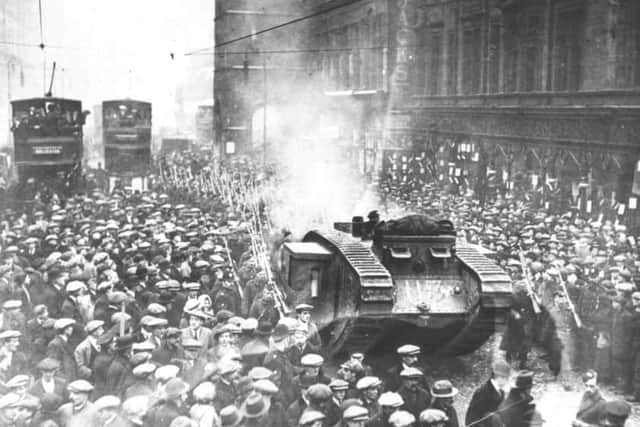Red Clydeside: When tanks rolled through the streets of Glasgow, ‘The Battle of George Square’ explained
and live on Freeview channel 276
Over 100 years ago, tanks and soldiers rolled through the streets of Glasgow as they tried to quell workers’ demands for a shorter working week and improved working conditions.
George Square hosted the event on January 31, 1919 which would go on to be remembered as ‘The Battle of George Square’ (as well as ‘Bloody Friday’ and ‘Black Friday’)
Advertisement
Hide AdAdvertisement
Hide AdThe city centre saw running battles between striking workers, police, and armed soldiers took place in response to fears of a communist uprising in the city.
While protestors were only calling for the working week to be cut down from 47 hours to 40 hours - as well as improved working conditions - but the local and Westminster government at the time believed the events to be the beginning of a ‘Bolshevik uprising’.
The events took place just months after the end of World War One. Many of the strikers were former soldiers demanding fairer working conditions.
Following the Great War, the cost of living skyrocketed, while wages remained static.


Advertisement
Hide AdAdvertisement
Hide AdThe strike was organised by the Scottish Trades Union Congress (STUC), which continues to represent workers and organise strikes in Glasgow today.
Another body, called the Clyde Workers Committee (CWC), believed more in direct action - having been founded to rally engineering workers who had been involved in a strike over pay in Glasgow in 1915, and had organised a rent strike later the same year.
They were far more radical in their politics and approach, having several heads of the organisation arrested for the publication of a ‘seditious’ article in their own magazine in 1916.
They also interrupted a council meeting about allowing semi-skilled workers to work in skilled workplaces during the war. CWC members drowned out the speaker by singing the socialist anthem; ‘The Red Flag’.
Advertisement
Hide AdAdvertisement
Hide AdBy 1919, the major players were released from jail and the CWC were active again. They went much further than the STUC at the George Square protest, demanding a 30 hour work week.
The British Government started feeling antsy as thousands of workers joined picket lines, a Glasgow power station was closed, and threatened to close tram travel across the city.
These strong-arm tactics by the CWC had the Government feeling that a violent uprising was just around the corner - despite no evidence of physical aggression from protestors.
The government’s fears stemmed from the Russian revolution two years previously - which had put the communists in power. Lenin soon made John Maclean, one of the Glasgow ringleaders behind the strikes Bolshevik consul for Scotland.
Advertisement
Hide AdAdvertisement
Hide AdIt was in this post-war red-scare climate that the strikes kicked off, with thousands of workers filling George Square.
As leaders of the strike met with the Lord Provost in the City Chambers to issue their demands, a red flag was raised in the middle of the crowd. Riot Police - who were made well aware of the supposed potential for a Bolshevik uprising - charged the crowd shortly after it was spotted.
Strikers hit back throwing missiles, like glass bottles, at the police, who promptly charged the crowd again. A total of 40 people, including innocent bystanders, were injured in the trouble.
Scottish Secretary Robert Munro alerted the UK government to the incident, who quickly mobilised troops from across Britain.
Advertisement
Hide AdAdvertisement
Hide AdSoldiers from the rest of Scotland and England were deployed rather than the Maryhill barracks due to fear that local soldiers might join up with workers.
Soldiers were deployed at strategic points in the city and were accompanied by six armed tanks.
David Kirkwood, a leader of the Red Clydeside movement was arrested for his role in organising the strike, alongside numerous other suspected communists.
The protest didn’t go on to achieve much - although the STUC, who distanced themselves from the militant protests continue to organise protests to this day - while the CWC was severely discredited by officials and suffered greatly from their ringleaders being jailed.
Advertisement
Hide AdAdvertisement
Hide AdFor Glaswegians at the time who had just finished up the most devastating war ever recorded at the time, and were fighting their way through a cost of living crisis, pushing for socialism seemed too much to handle after the events of Red Clydeside.
Comment Guidelines
National World encourages reader discussion on our stories. User feedback, insights and back-and-forth exchanges add a rich layer of context to reporting. Please review our Community Guidelines before commenting.
